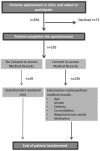Symptom burden in patients with chronic kidney disease not requiring renal replacement therapy
- PMID: 29225808
- PMCID: PMC5716066
- DOI: 10.1093/ckj/sfx057
Symptom burden in patients with chronic kidney disease not requiring renal replacement therapy
Abstract
Background: Although evidence shows that patients with end stage renal disease (ESRD) experience a high symptom burden which impacts on quality of life (QoL), less is known about patients with earlier stages of chronic kidney disease (CKD). This study aimed to explore symptom burden and potential contributing factors in patients with CKD Stage 1-5 not requiring renal replacement therapy (RRT).
Methods: Patients with CKD Stage 1-5 and not on RRT were asked to report their symptoms using the Leicester Uraemic Symptom Score (LUSS), a questionnaire which assesses the frequency and intrusiveness of 11 symptoms commonly reported by kidney patients.
Results: Symptoms were assessed in 283 CKD Stage 1-5 patients: 54% male, mean age 60.5 standard error± 1.0, mean eGFR 38ml/min/1.73m2. Some 96% (95% confidence interval 93.2-98.0) of participants reported experiencing at least one symptom, the median reported being six. Excessive tiredness (81%;76.0-85.6), sleep disturbance (70%;64.3-75.3) and pain in bones/joints (69%;63.4-74.6) were reported most commonly. Overall, few significant associations were found between biochemical markers of disease severity and symptom burden. Men tended to report fewer symptoms than women and South Asian patients often described experiencing symptoms with a greater severity. Older patients found musculoskeletal symptoms more intrusive whereas younger patients found reduced concentration more intrusive.
Conclusions: Our findings suggest that patients with CKD stages 1-5 experience a multitude of symptoms that could potentially impact QoL. Using multidimensional tools like the LUSS, more exploration and focus could provide a greater opportunity for patient focussed symptom control from the earliest stages of CKD.
Keywords: age; chronic kidney disease; ethnicity; gender; pre-dialysis; quality of life; symptom.
Figures


References
-
- Almutary H, Bonner A, Douglas C.. Symptom burden in chronic kidney disease: a review of recent literature. J Ren Care 2013; 39: 140–150 - PubMed
-
- Almutary H, Bonner A, Douglas C.. Which patients with chronic kidney disease have the greatest symptom burden? A comparative study of advanced CKD stage and dialysismodality. J Ren Care 2016; 42: 73–82 - PubMed
-
- Murtagh FEM, Addington-Hall JM, Donohoe P. et al. Symptom management in patients with established renal failure managed without dialysis. EDTNA ERCA J 2006; 32: 93–98 - PubMed
-
- Douglas C, Murtagh FE, Chambers EJ. et al. Symptom management for the adult patient dying with advanced chronic kidney disease: a review of the literature and development of evidence-based guidelines by a United Kingdom Expert Consensus Group. Palliat Med 2009; 23: 103–110 - PubMed
-
- Murtagh FEM, Addington-Hall JM, Edmonds PM. et al. Symptoms in advanced renal disease: a cross-sectional survey of symptom prevalence in stage 5 chronic kidney disease managed without dialysis. J Palliat Med 2007; 10: 1266–1276 - PubMed
LinkOut - more resources
Full Text Sources
Other Literature Sources
Research Materials
Miscellaneous

